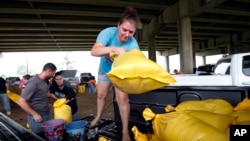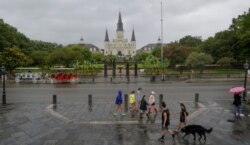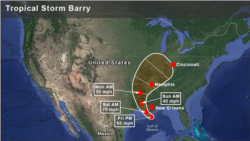Updated July 13, 2019, at 3:25 a.m.
Residents in New Orleans fortified their homes and stocked up on supplies Friday as Tropical Storm Barry began to roll in from the Gulf of Mexico.
City officials advised residents to shelter in their homes, except for those in two coastal parishes south of the city, where mandatory evacuations were ordered.
Early Saturday the National Weather Service extended tornado warnings in the New Orleans area
Tourists largely left the city Friday, ahead of the storm’s expected landfall early Saturday. Some airlines canceled Saturday outbound flights.
The National Hurricane Center expected Barry to strengthen before landfall and hit the coast as a Category 1 storm. It would be the first Atlantic hurricane of the season.
City residents received some good news Friday night: The Mississippi River is expected to crest in New Orleans around 17.1 feet (5.2 meters) Monday, not 19 feet (5.8 meters) as had been predicted. The levees protecting the city range from about 20 to 25 feet (6 to 7.5 meters) in height.
The main threat from the storm was expected to be its flood potential rather than its high winds. The storm was widely being seen as a test of the city's weather defenses put in place following Hurricane Katrina in 2005, which left about 1,800 people dead.
U.S. President Donald Trump declared a state of emergency in Louisiana on Thursday night, authorizing the Department of Homeland Security and the Federal Emergency Management Agency to coordinate federal funds and resources to help the state cope with the storm and its aftermath.
Barry's maximum sustained winds Friday night were clocked at 100 kph, and the storm was expected to drop as much as 60 centimeters of rain in some places, leading to severe flooding. The storm was on a path toward Morgan City, which was surrounded by water. It’s nearly 140 kilometers southwest of New Orleans.
New Orleans, which was already dealing with floods from Wednesday's fierce rainstorms, was likely to see more flash flooding. Forecasters predicted the city could expect as much as 51 centimeters of additional rain, pushing the Mississippi River's crest close to the top of the 6-meter-high levees protecting the city.
Baton Rouge also faced threats of flash flooding.
Louisiana Gov. John Bel Edwards has already declared a state of emergency and deployed the National Guard.
Mandatory evacuations have been ordered for about 10,000 people living near the stretch of the Mississippi closest to the Gulf. A storm surge warning was in effect for southern and southeastern Louisiana.
Along with heavy rain and strong winds, Barry could bring dangerous storm surges and tornadoes before it moves inland and weakens.










